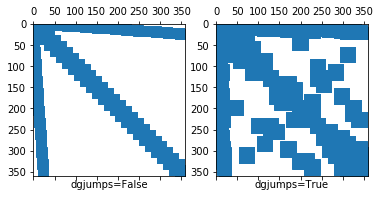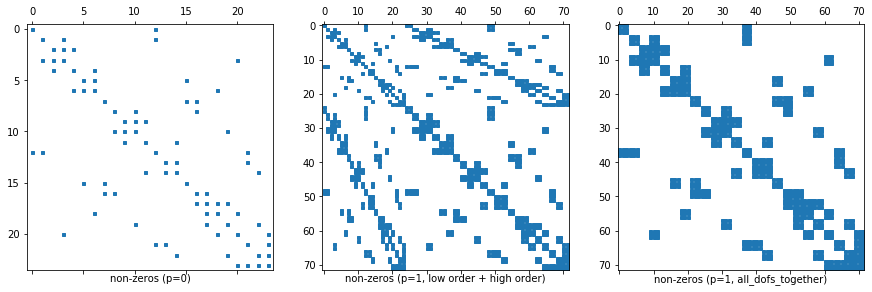This page was generated from unit-2.8-DG/DG.ipynb.
2.8 Discontinuous Galerkin Methods¶
Use discontinuous finite element spaces to solve PDEs.
Allows upwind-stabilization for convection-dominated problems
Requires additional jump terms for consistency
Interior penalty DG form for \(-\Delta u\):
with jump-term over facets:
and averaging operator
DG form for \(\Div (b u)\), where \(b\) is the given wind:
[1]:
import netgen.gui
from netgen.geom2d import unit_square
from ngsolve import *
mesh = Mesh(unit_square.GenerateMesh(maxh=0.3))
The space is responsible for allocating the matrix graph. Tell it that it should reserve entries for the coupling terms:
[2]:
order=4
fes = L2(mesh, order=order, dgjumps=True)
u,v = fes.TnT()
Every facet has a master element. The value from the other element is referred to via the Other() operator:
[3]:
jump_u = u-u.Other()
jump_v = v-v.Other()
n = specialcf.normal(2)
mean_dudn = 0.5*n * (grad(u)+grad(u.Other()))
mean_dvdn = 0.5*n * (grad(v)+grad(v.Other()))
Integrals on facets are computed by setting skeleton=True. * dx(skeleton=True) iterates over all internal faces * ds(skeleton=True) iterates over all boundary faces
[4]:
alpha = 4
h = specialcf.mesh_size
a = BilinearForm(fes)
diffusion = grad(u)*grad(v) * dx \
+alpha*order**2/h*jump_u*jump_v * dx(skeleton=True) \
+(-mean_dudn*jump_v-mean_dvdn*jump_u) * dx(skeleton=True) \
+alpha*order**2/h*u*v * ds(skeleton=True) \
+(-n*grad(u)*v-n*grad(v)*u)* ds(skeleton=True)
a += diffusion
a.Assemble()
[5]:
f = LinearForm(fes)
f += SymbolicLFI(1*v)
f.Assemble()
[6]:
gfu = GridFunction(fes, name="uDG")
gfu.vec.data = a.mat.Inverse() * f.vec
Draw (gfu)
DG requires a lot of additional matrix entries:
[7]:
print ("a nze:", a.mat.nze)
fes2 = L2(mesh, order=order)
a2 = BilinearForm(fes2)
a2 += SymbolicBFI(u*v)
a2.Assemble()
print ("a2 nze:", a2.mat.nze)
a nze: 18900
a2 nze: 5400
Next we are solving a convection-diffusion problem:
[8]:
alpha = 4
h = specialcf.mesh_size
The IfPos checks whether the first argument is positive. Then it returns the second one, else the third one. This is used to define the upwind flux. The check is performed in every integration-point on the skeleton:
[9]:
b = CoefficientFunction( (20,5) )
uup = IfPos(b*n, u, u.Other())
convection = -b * u * grad(v)*dx + b*n*uup*jump_v * dx(skeleton=True)
acd = BilinearForm(fes)
acd += diffusion + convection
[10]:
acd.Assemble()
[11]:
gfu = GridFunction(fes)
gfu.vec.data = acd.mat.Inverse(freedofs=fes.FreeDofs(),inverse="umfpack") * f.vec
Draw (gfu)
Hybrid Discontinuous Galerkin methods¶
use additionally the hybrid facet variable on the skeleton:
the jump-term is now replaced by the difference \(u - \widehat u\).
No additional matrix entries across elements are produced. Dirichlet boundary conditions are set as usual to the facet variable:
[12]:
order=4
V = L2(mesh, order=order)
F = FacetFESpace(mesh, order=order, dirichlet="bottom|left|right|top")
fes = FESpace([V,F])
u,uhat = fes.TrialFunction()
v,vhat = fes.TestFunction()
Now, the jump is the difference between element-term and facet-term:
[13]:
jump_u = u-uhat
jump_v = v-vhat
[14]:
alpha = 4
condense = True
h = specialcf.mesh_size
n = specialcf.normal(mesh.dim)
a = BilinearForm(fes, condense=condense)
dS = dx(element_boundary=True)
a += grad(u)*grad(v)*dx + \
alpha*order**2/h*jump_u*jump_v*dS + \
(-grad(u)*n*jump_v - grad(v)*n*jump_u)*dS
b = CoefficientFunction( (20,1) )
uup = IfPos(b*n, u, uhat)
a += -b * u * grad(v)*dx + b*n*uup*jump_v *dS
a.Assemble()
f = LinearForm(fes)
f += SymbolicLFI(1*v)
f.Assemble()
gfu = GridFunction(fes)
print ("A non-zero elements:", a.mat.nze)
A non-zero elements: 4650
[15]:
if not condense:
inv = a.mat.Inverse(fes.FreeDofs(), "umfpack")
gfu.vec.data = inv * f.vec
else:
f.vec.data += a.harmonic_extension_trans * f.vec
inv = a.mat.Inverse(fes.FreeDofs(True), "umfpack")
gfu.vec.data = inv * f.vec
gfu.vec.data += a.harmonic_extension * gfu.vec
gfu.vec.data += a.inner_solve * f.vec
Draw (gfu.components[0], mesh, "u-HDG")
Remarks on sparsity pattern in NGSolve¶
Remark 1: The sparsity pattern is set up a-priorily¶
The sparsity pattern of a sparse matrix in NGSolve is independent of its entries (it’s set up a-priorily).
We can have “nonzero” entries that have the value 0
Below we show the reserved memory for the sparse matrix and the (numerically) non-zero entries in this sparse matrix.
[16]:
fes2 = L2(mesh, order=order, dgjumps=True)
u,v=fes2.TnT()
a3 = BilinearForm(fes2)
a3 += u*v*dx + (u+u.Other())*v*dx(skeleton=True)
a3.Assemble()
[17]:
import scipy.sparse as sp
import matplotlib.pylab as plt
plt.rcParams['figure.figsize'] = (12, 12)
A = sp.csr_matrix(a3.mat.CSR())
fig = plt.figure(); ax1 = fig.add_subplot(121); ax2 = fig.add_subplot(122)
ax1.set_xlabel("numerically non-zero"); ax1.spy(A)
ax2.set_xlabel("reserved entries (potentially non-zero)"); ax2.spy(A,precision=-1)
plt.show()
<Figure size 1200x1200 with 2 Axes>
Remark 2: Sparsity pattern with and without dgjumps=True is different¶
[18]:
a1 = BilinearForm(L2(mesh, order=order, dgjumps=False)); a1.Assemble()
a2 = BilinearForm(L2(mesh, order=order, dgjumps=True)); a2.Assemble()
A1 = sp.csr_matrix(a1.mat.CSR())
A2 = sp.csr_matrix(a2.mat.CSR())
fig = plt.figure(); ax1 = fig.add_subplot(121); ax2 = fig.add_subplot(122)
ax1.set_xlabel("dgjumps=False"); ax1.spy(A1,precision=-1)
ax2.set_xlabel("dgjumps=True"); ax2.spy(A2,precision=-1)
plt.show()

Remark 3: Dof numbering of higher order FESpaces¶
In
NGSolveFESpaces typically have a numbering where the first block of dofs corresponds to a low order subspace (which is convenient for iterative solvers).For L2 this means that the first dofs correspond to the constants on elements.
You can turn this behavior off for some spaces, e.g. for L2 by adding the flag
all_dofs_together.
We demonstrate this in the next comparison:
[19]:
plt.rcParams['figure.figsize'] = (15, 15)
fig = plt.figure()
ax = [fig.add_subplot(131), fig.add_subplot(132), fig.add_subplot(133)]
for i, (order, all_dofs_together, label) in enumerate([(0,False, "non-zeros (p=0)"),
(1,False,"non-zeros (p=1, low order + high order)"),
(1,True,"non-zeros (p=1, all_dofs_together)")]):
a = BilinearForm(L2(mesh,order=order,dgjumps=True,all_dofs_together=all_dofs_together))
a.Assemble()
ax[i].spy(sp.csr_matrix(a.mat.CSR()),markersize=3,precision=-1)
ax[i].set_xlabel(label)

[ ]: